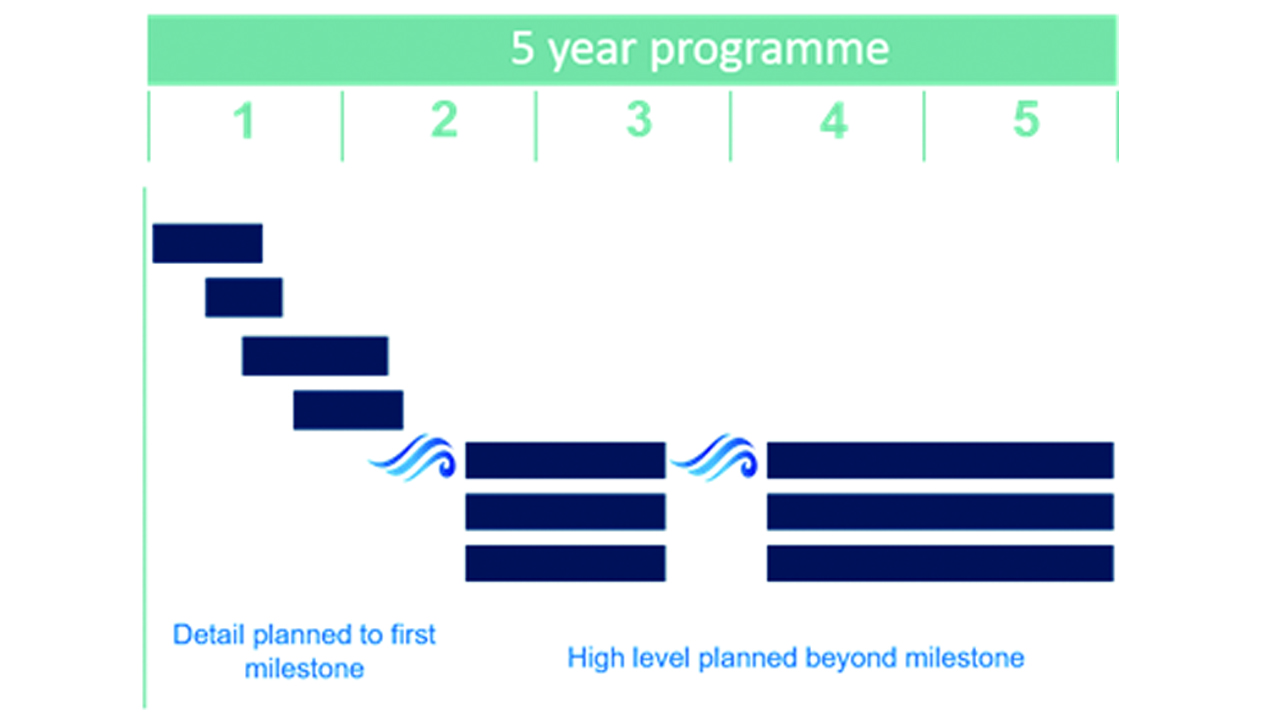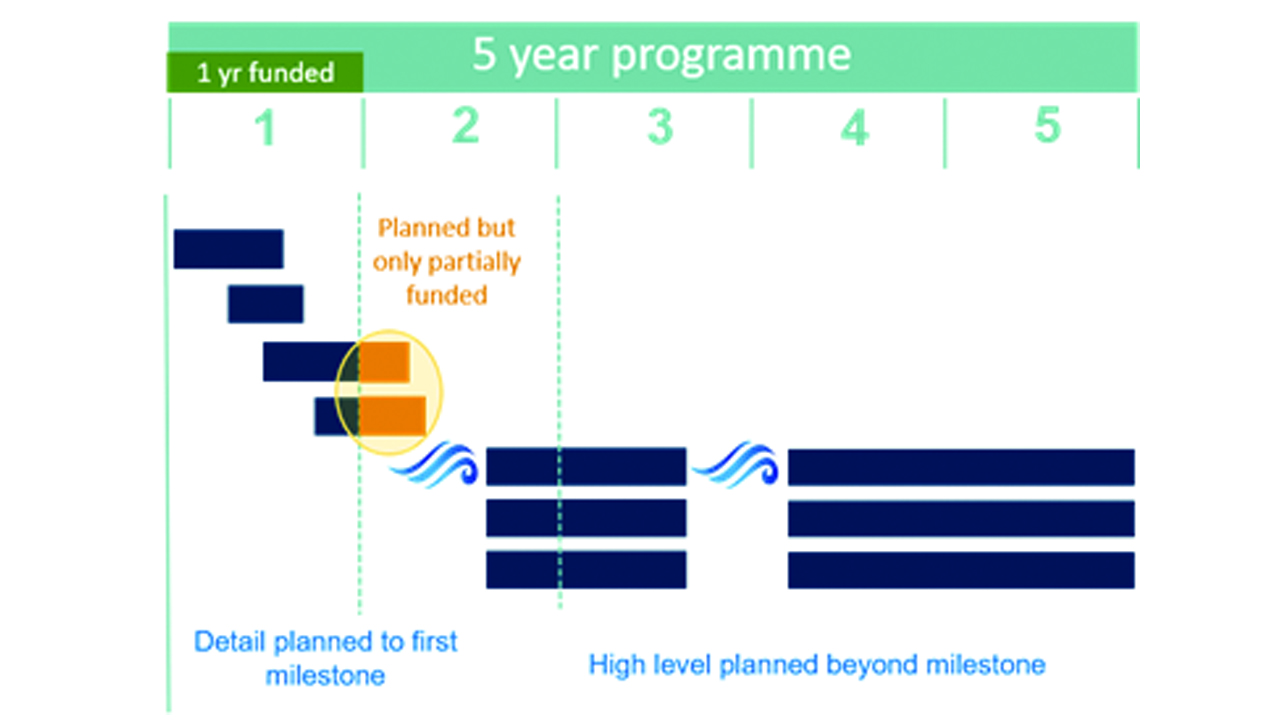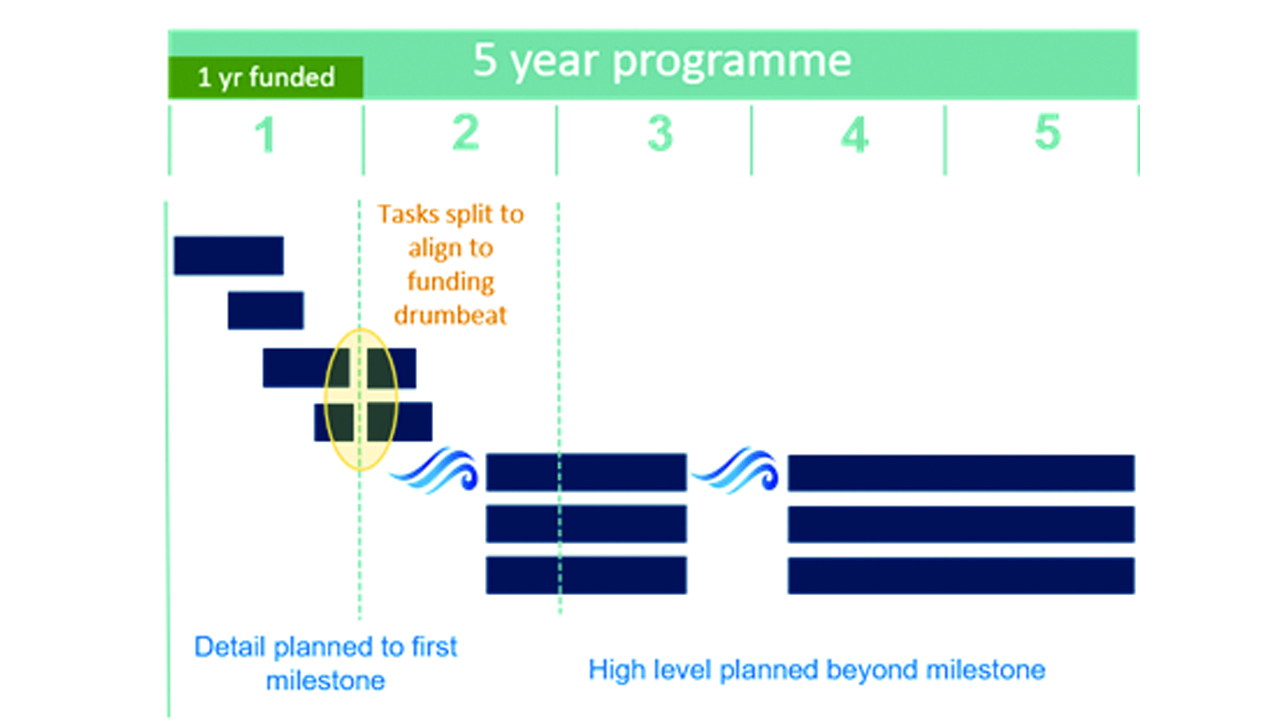Rolling wave planning (part two) - can it break on a fixed year financial funding model?
Author: Peter Mill, programme management consultant
On all critical national infrastructure and major complex programmes, there is a continuous conflict between the funding cycle and the planning process. While funding is necessary to progress, it is sometimes out of sync with the overall programme.
In the previous article, I explained ‘rolling wave planning’, the concept that progressive elaboration of the detailed plan is the right approach to ensure the long-term plan remains accurate, measurable and achievable. Even when steps are out of sync, the concept of near-term detail planning and longer-term predictive planning, will help keep project reporting and programme plans as realistic and accurate as possible.
But how do you apply rolling wave planning in practice, staying close to calm water, avoiding the storms that may be hiding beyond the horizon?
Riding the rolling waves
Our behaviours frequently cause us to make decisions that solve a near term problem whilst generating a bigger one in the future. By trying to plan too far ahead, we create unrealistic and inaccurate forecasts that could impact bigger decisions further into the project.
Rolling wave can result in continuous low-level planning, with packages being progressively ‘detail planned’ as they come over the horizon. As time progresses, we have a better understanding of how the work will be undertaken and can therefore plan in better detail. This can mean a volume of changes being processed every month as more details are shared or finalised.
More mature applications of rolling wave planning will plan the wave in accordance with the programme lifecycle (e.g: Concept, Definition, Development, Handover and Closure - as defined in the APM Body of Knowledge) and associated major milestones. With this approach, every part of the programme is planned in detail (work packages) up to the next major milestone (e.g. preliminary design review ‘PDR’), against an agreed set of planning principles and programme assumptions. The remainder of the programme beyond PDR is outlined in higher level (planning packages) and milestones.
Once the programme has achieved the maturity required to clear the PDR, it would enter another wave of the planning process; the next phase between PDR and concept design review (CDR). This would be enabled by the project team stepping forward together using a common set of planning assumptions and behaviours. This is more akin to a stormy sea, with the peaks and troughs of waves representing periodic planning efforts.

Benefits of this approach:
- Consistency between the plan and the lifecycle. Planning is undertaken in discrete chunks, aligned with the known scope (usually on contract) of the imminent phase of the programme. Assumptions are documented and applied consistently across all elements of the programme.
- An accurate baseline can be set. Planning each phase is a collaborative effort, ensuring that interfaces, dependencies, and deliverables are confirmed as part of the baselining process, and before execution of that phase commences against which change can be accurately measured and controlled.
- Progressive assurance of the baseline plan. Phase-focused integrated baseline reviews assess the maturity, integrity, and completeness of the detailed plan, using documented planning assumptions as a foundation. The structure, logic and assumptions underpinning the future phases are also reviewed, but in the context of future, higher level plans. In this way, rolling wave planning can be supported by rolling wave assurance.
How funding can impact the programme
Programme planning is often aligned to programme funding cycles, and hence approval gates and phase contracts. Whilst this is intuitively a sensible approach, major difficulties can arise in practice.
Few programme sponsors are willing or able to fully commit funding to the full duration of the programme. Numbers are huge, sometimes into £billions, and fiscal governance for programmes requires:
- achieving solid budgetary positions (sufficient to ensure programme liquidity)
- understanding forecast funding requirements
- maintaining visibility of spend and associated delivery achievement
- ensuring efficient use of funds
- effective contract management
- focussed risk and change management arrangements.
In practice, this means that programme funding profiles are often misaligned with the ‘natural’ planning (including budgeting and contract/commercial) lifecycle.
Different industrial sectors apply this in different ways, to differing drumbeats. Regulated industries (such as the utilities sector) work to longer funding periods aligned to contract frameworks. For example, the water industry works to a five year asset management plan (AMP), energy to the five year RIIO funding period and in transport, rail’s five year control periods (CP) and highway’s five year road investment strategy (RIS).
However, other sectors such as defence, education, IT or the arts, and also internal company processes, often fund programmes on a rolling annual drumbeat:

As shown in the figure above, whilst there is an imperative to plan the full programme, in terms of work and resource (budget), taking account of rolling wave principles, there is a disconnect with the allocated funds. Whilst funds are absolutely not the same as budget, funding does impact the actions a programme may take.
- Some programme managers will only plan within current funding limits (time or value), essentially adopting a short-term view, an inherently inefficient way of working. How often is there a gap between funding allocations that drives a break or pause in the programme?
- Whilst there is nothing to stop a manager planning the programme as above, the funding limits will restrict ability to commit spend beyond the funding limit. Purchases cannot be made; resources cannot be fully allocated. Recruitment may be limited. Planning consents may be delayed. The programme manager ends up instructing the whole plan to be split at the funding limit, which may be a date (Financial Year) or a cost value. Activities which do not have a logical deliverable, breakpoint or outcome are broken at a full year end. This is just bad planning and reduces the usability of the plan.
- Programme managers are driven to ‘spend’ all the allocated funds in a specific funding period. This often comes as a request for a spending drive towards the end of a fiscal year. However, this may not always be right for the project – it can drive out of sequence working, early procurement, and ultimately rework at a later stage in the programme.
- Where funding is allocated in stages, the outcome can be that the programmes often have to stop / start or fluctuate in intensity whilst awaiting decisions: the so-called planning blight. This means there is additional time 'on pause' and lost time re-energising activities. It may be more efficient to recognise and control the risks of continuous funding.

Back to basics
So – what’s the solution? Ideally, to separate the funding from planning as far as possible; in the extreme, planning can be done with zero visibility of available funds. Clearly, the robustness of that plan will be questionable, but in principle, the plan can still be created.
The key is to remember the definitions and purpose:
A) Budget: a quantitative expression of a plan or target for a specific effort, over a defined period of time (monthly, quarterly or yearly etc.) It should include planned resource quantities, costs and expenses, assets, and liabilities. Budget cannot be spent – it is just a target.
B) Funds: Funds represent money available for expenditure in the accomplishment of the effort. The estimate at completion (EAC) provides visibility of actual required cost by forecasting the actual funding requirements for any approved statement of work element. Funds are spent.
Not the same thing. So why treat them as if they are?
Why not create a well-constructed long-term plan for the programme that reflects the best understanding of funding profile at the time? If there is only one year of firm funding, that should not limit the long-term planning process. As discussed earlier, rolling wave is a good approach to limit the impacts of schedule uncertainty.
The key is to ensure that the programme’s termination liability (essentially spend + commitment) never breaches the limit of funding. Other than that, the plan is just an aspiration, a representation of the intended work and consumption of resources. Crucially – if the plan must change as a result of subsequent funding changes, it can.
To close, another challenge:
In my previous article I discussed the impact that consequences have on behaviour: if you are in a position of programme sponsorship, is your programme set up to deliver the desired result. Are there undesired behaviours causing you to make decisions that solve a near term problem whilst generating a bigger one in the future?
Think about the unintended consequences of staged funding on the overall programme. Would structuring your approval, funding, governance and assurance processes, metrics and reward mechanisms in a way that positively reinforces the right behaviour, make the consequences immediate and likely?
For more information and a step by step guide on the application of rolling wave planning, download our Right Result Playbook for insights on where you are currently performing and where there is scope for improvement to support programme assurance.


